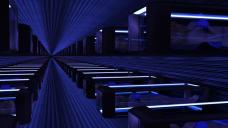Help complex/low light iray renders
I tend to like complex and low light scenes and or scenes with many lights, but I keep running into an issue where my convergence stops advancing like the pic I attached where it stops at 1.07% no matter how long it runs. I would greatly appreciate any help on resolving this without having to add a bunch of light. I have a GTX970 with 4G and using the latest release of DAZ. I have this issue all to often and am pretty close to giving up on Daz as I either have to radically change my scenes or not render them.
This scene is using light from the boxes, many instances, and mirrors on both ends of the room for the infinity look. Even removing the girl and hair I could only get this to 1.8%
Thanks in advance for helping out




Comments
Too many reflections. You can try a major HW upgrade including video card but you are stuck otherwise unless you make that glass no reflective which will take away the glass look.
One way of doing this is to up your luminence (light) LEVELS to have everything very well lit. That will speed the render considerably. Then you use the tone mapping shutter speed and f/stop, especially to set the exposure level you want...
Both of these rendered for the same amount of time. The first is with the light levels set for a low light render. The second is with much more light and the exposure adjusted with the tonemapping.
Try changing the path length (I think that is it, under filter. I'm not at home just now so guessing). Try it at 5 and work up until you see all the reflections you require. That should speed things up a bit. You should know when to stop as there will no longer be a black hole where the reflections stop.
Thanks for the suggestions. I was able to get it to render ok by changing the camera settings - much brighter than I wanted but I will experiment with that as well as with paths.
As for hardware upgrades - I don't have a top of the line system but its no slouch either. Curious what you think it would take to handle the reflections?
In the tone mapping, you are not limited to 'real' values...if you need to you can go to higher/lower than what a real camera could do.
Note that the only hardware that really matters in an Iray render is your video card — if it's an NVidia card, if it has enough CUDA cores, if it has enough VRAM to hold your entire scene; if you can answer all these with "yes", then your scene will render on the card. If not, it will render much more slowly using your computer's main CPU.
Note also that "slowly" will be the only difference. However the render is processed, CPU or video card, it will always look exactly the same. Render settings, though, are different; those you will have to tweak to get a good result (e.g. your problem with reflections).
Hi SkyDaddyD,
The problem may be as simple as a fully-enclosed set. Does your set have all four walls, floor, and ceiling visible? If so, Iray will chase each beam of light bouncing off each surface, back and forth. The glossier your surfaces, the longer each beam will reflect. Even with only semi-gloss surfaces, renders in a fully-enclosed set will take for...ev...er -- regardless of your lighting, even with a high-end graphics card.
If that's your situation, hide the wall behind your camera, and/or the floor or ceiling, whichever is out-of-frame. If your far wall reflects the wall behind the camera, and if both the ceiling and floor are in-frame, adjust your camera angle so that either the ceiling or floor is out-of-frame, and hide it. Basically, you need at least one open side on the set, so the light can go out into unbounded space. Iray stops calculating a beam's path once that beam is out in unbounded space ... so with at least one open side your renders will go much faster.
Below is a render from my Superfund Diner set-in-progress. There are plenty of reflections off the front and end windows, as well as from the chrome finish on the booths and table. It's an interior shot, but I've hidden the ceiling ...
... and the set includes a Curtain Box: a cube with no top or bottom, but with both inner and outer faces. All of the Curtain Box surfaces are set to Iray Velvet black with Glossy Reflectivity to 0 and Glossy Roughness to 1. The Curtain Box is tall enough to prevent exterior lights from shining in through the open (hidden) ceiling, and the black velvet shader soaks up any beams that strike it. You can see the Curtain Box above the diner in the screenshot below.
That render reached 93% convergence at 5000 iterations in about 23 minutes, on an NVIDIA GeForce GTX 980 Ti graphics card, which is about normal for my interior 1280x720 renders with no characters. If I add a character, as in the second scene below, it takes about 1h40m to render.
If I tried to render that scene with the ceiling shown -- that is, with the set fully-enclosed -- it would have been very slow, and probably would not have reached even 80% convergence in 5000 iterations.
So, again, if you haven't already, find a way to hide a wall, floor, or ceiling ... so light beams can escape your interior into unbounded space.
Crissie